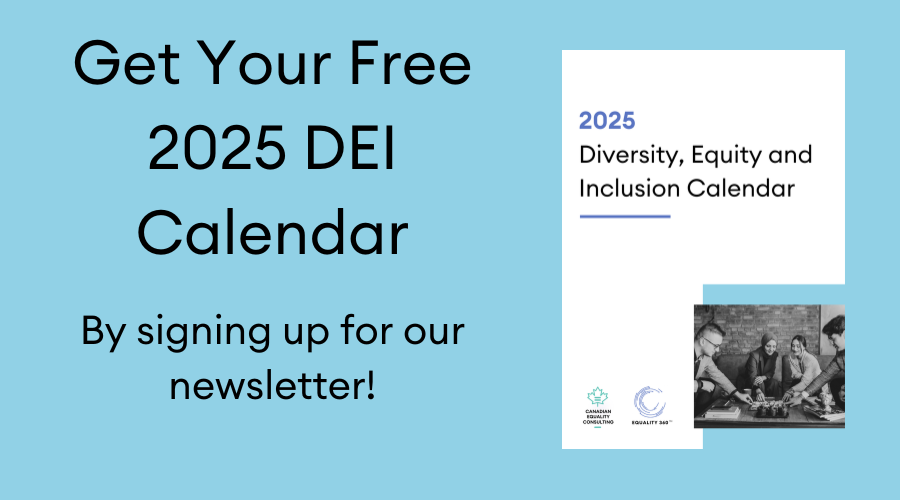Race & Antiracism
Racism and antiracism in the workplace is an important topic. By asking questions such as: what is antiracism? Why is cultural diversity important in the workplace? How can we promote racial equality in the workplace? we aim to start a productive conversation about why and how to make your workplace more diverse and inclusive.
Currently, 3 out of 5 Black Canadians note that racism is a problem in their workplace. A new study from Catalyst shows that “52% of Indigenous Peoples working in Canada said they are regularly on guard [against experiencing] bias… with women on guard (67%) significantly more than men (38%).” This same study noted that Indigenous employees continue to face entrenched bias and discrimination issues that impact their well-being and professional advancement. Two-thirds of South Asian employees report that workplace racism has damaged their employer/employee relationship. And many other Canadians of colour continue to share their experiences with microaggressions and harassment in the workplace.
We also know that increased public dialogue on these issues often results in the impacted groups bearing the burden of these discussions. The most intense period of dialogue and publicity on the #BlackLivesMatter movement in spring of 2020 coincided with a decline in mental health scores about Black Canadians by 1.8 points. Racial inequity and having to constantly combat racial discrimination takes its toll on employees. Catalyst’s new report on combatting the emotional tax put on people of colour in Canadian workplaces noted that “22%-42% of people highly on guard against bias report high rates of sleep problems, and many people consider leaving their jobs or report hiding their true identities and unique selves to self-protect against…” emotional tax, or “feeling different from peers at work because of gender, race, and/or ethnicity, being on guard to experiences of bias, and the associated effects on health, well-being, and ability to thrive at work.”
These issues are not limited solely to office-based workplaces either. During the COVID-19 pandemic, Statistics Canada found that visible minorities formed a larger representative proportion of front-line workers, including “nurse aides, orderlies, and patient service associates.” This means that Canadians of colour faced increased exposure to the virus and were more likely to get sick than other Canadians, highlighting the social determinants of health. Visible minorities were also much more likely to be disproportionately economically and socially impacted by the COVID pandemic.
Antiracism will also benefit your organization. Here’s some quick diversity in the workplace statistics about why employee diversity matters in the workplace:
- When employees don’t feel supported at work, creativity and innovation suffer. McKinsey noted that companies that performed worst on diversity were almost 30% more likely to underperform on profitability.
- Discrimination in the workplace can harm employee health and an organization’s productivity. A study by CareerTrend noted that companies with less racial equity are more likely to have employees with lower productivity, lower morale, and higher staff turnover.
- PRNewswire notes that 70% of jobseekers value a company’s commitment to diversity when considering whether to apply to a job posting.
- Edelman notes that 64% of consumers around the world will buy or boycott a brand solely because of its position on a social or political issue.
What is antiracism?

In “How to be Antiracist,” scholar and activist Ibram X. Kendi defines an antiracist as “[o]ne who is supporting an antiracist policy through their actions or expressing an antiracist idea.” Moving from “I’m not racist” to “I am antiracist” requires an action mindset and a commitment to change. It asks people to engage critically with their own biases. As Kendi explains: “the only way to undo racism is to consistently identify and describe it — and then dismantle it.” Becoming antiracist requires a shift in perspective to understanding that we all play a role in systemic oppression. Even if we didn’t personally create the system of white supremacy, we may passively benefit or suffer under it. And we simultaneously have the power to change these conditions through our choices and actions. Antiracist work is found not only in the grand gestures of protests and media coverage, but more importantly in the small everyday choices of our workplaces, our families, and our communities.
There is often a belief that simply “not being racist” is sufficient to combat racism. However, as we can see in the ongoing struggles for racial equality in Canada and internationally, this approach has been ineffective. Viewing racism as a distant societal issue that needs intervention from larger powers (government, policy-makers, etc.), as opposed to a systemic problem that needs to be tackled in all of our everyday lives, removes individual responsibility to combat racism and distances each of us from the problem.
Why is cultural diversity important in the workplace?

Even beyond the current requirement to make the workplace inclusive and equitable for all employees, the need for an inclusive workplace is only likely to grow: according to Great Place to Work, the incoming generation of Gen Z employees is likely to be the most diverse workforce to date, with “47% of Gen Z employees identifying as [black, indigenous persons of colour]. By comparison, 39% of Millennial workers…as [people of colour], versus 34% of Gen X and only 25% of Boomers.” Being a responsive employer means considering the needs of a more diverse hiring pool and workforce.
When people are marginalized in their organization, they have less capacity to campaign for better and more inclusive workplaces. When the Financial Post analyzed 2019 required reporting under the Canada Business Corporations Act, they found that “out of the 23 boards and 255 director positions total, only 14 directors, or approximately 5.5 per cent, identified as belonging to a visible minority.” They also found that Indigenous and visibly disabled directors each make up less than 1% of representation on boards and in director positions. Research shows that employees in marginalized groups are less comfortable negotiating for benefits or asking for a raise due to discriminatory workplace practices and senior leadership levels dominated by white Canadians, and this discomfort has risen even further under COVID-19. Employers have a responsibility to mitigate these discriminatory workplace practices in order to support employees, and create a more productive, satisfied workforce.
To quote Vox, “antiracism isn’t comfortable, just like racism isn’t comfortable for black people and people of color.” However consistent, committed everyday antiracist action will continue to dismantle white supremacy more effectively than simply claiming to not be racist, and leaving the conversation to die from inaction.
What are the benefits of racial diversity?

Vanmala Sunder Hiranandani, a teacher at University College Copenhagen, published a paper in 2012 entitled “Diversity Management in the Canadian Workplace: Towards an Antiracism Approach,” where she noted that “[e]mbracing diversity in its true spirit is essential if diverse employees are to be retained after recruitment, because even if diversity programs succeed in recruiting skilled diverse employees, a prejudiced workplace may not be able to retain such employees for long or may not be able to provide the work environment needed for diverse employees to perform to their full potential.”
Essentially, an inclusive workplace is an effective workplace. Currently, only approximately half of all discrimination and harassment complaints in the workplace result in any repercussions, and the employees who are harassed are more likely to experience worse mental and physical health, and face career challenges, than their peers. Similarly, a 2020 report by Mercer noted that Black/African American and Hispanic/Latino populations are underrepresented at every career level above support staff when compared to “their representation in the general population.” Similarly, more than 40 million Americans have filed for unemployment protection since the COVID outbreak began, but while numbers have started to improve for white workers, Black unemployment has continued to rise.
Issues like this are clearly systemic in nature and are pervasive. And while an organization may have many competing priorities, it’s clearly shown that being strategic with inclusive gender, ethnic, and racial diversity practices results in a happier, more diverse, and more productive employee base, to the extent that companies that prioritize diversity are at least 15 percent more likely to experience above-average financial returns.
What is an example of racial diversity?

A number of major companies have committed to increased diversity, equity, and inclusion work in their own practices. While every organization’s approach to antiracism will differ slightly according to their individual needs, there are a number of best practices and lessons learned that can be taken on-board from these models.
For instance, the University of Massachusetts Amherst released a study on “Evidence-Based Ideas to Increase Diversity, Equity, and Inclusion in the Workplace,” which examined the full cycle of change within the workplace, and noticed a key trend. Specifically, when managers and other organizational leaders get involved from the start, diversity and inclusion efforts are more successful. Involving leadership early provides a chance for early input, increased buy-in, and smoother implementation.
Similarly, a Deloitte study that interviewed Diversity and Equity leaders from leading non-American companies noted that success was achieved when there were multiple simultaneous initiatives and many sources of feedback implemented. This means measuring based on different indicators and incorporating diverse employee perspectives into the responses.
Robert Livingston, an expert in racial equity and diversity in the workplace, points to Massport as a positive example of institutionalizing antiracism effectively. Massport owns a large amount of real estate in Boston, including the Boston Logal International Airport, and decided to leverage its new commercial contacts to embrace diversity. Livingston notes that “[i]n addition to evaluating three traditional criteria—the developer’s experience and financial capital, Massport’s revenue potential, and the project’s architectural design—they added a fourth criterion called “comprehensive diversity and inclusion,” which accounted for 25% of the proposal’s overall score, the same as the other three [criteria].” This meant that developers of multi-million-dollar commercial real estate deals suddenly had to prioritize racial diversity in their proposals – with measurable impact.
While making sustainable change on issues of racial equity is challenging, recommendations and examples such as these can help a company understand that enacting meaningful progress on moving towards antiracist practices is achievable.
How is racial diversity calculated?

A phenomena as complex as “diversity” is difficult to quantify. However, there are a number of existing indexes created specifically to achieve this goal. For instance, Simpson’s Diversity Index is a single metric that measures two critical elements of diversity in an organization: richness, how many diverse identities you have in an organization, and evenness, how evenly represented they are across the organization. The higher the overall score, the more diverse the organization is. This index can also help an organization improve in other ways as well, for instance ensuring they have easy access to demographic data and allowing them an easy point of reference to other organizations in their field through Namely’s benchmarking reports. By knowing specific areas of shortfalls, organizations can engage in more concrete goalsetting and ensure the ongoing progress is analyzed effectively.
This emphasis on follow-through is key. Currently, 65% of 321 executives of large global companies surveyed by Forbes Insights claimed to have a plan in place to recruit a diverse workforce — but only 44 percent employ retention programs. There is a gap in collective accountability and progress on issues of diversity and inclusion and having an established metric measuring progress and shortfalls can help mitigate this pattern.
Indexes like these are also effective because they also require an organization to set goals, collect data, and examine change over time. As indexes are also used in various other facets of an organization, for instance profit and human resources measurements, familiarity with an indexing system will support positive progress on diversity issues as well. Indexes such as these also promote transparency, accountability, and communication with key stakeholders.
With that said, racism is a complicated issue. Sometimes it is tempting for an organization to view it solely numerically, for instance focus on achieving a certain quota in hiring or offering a certain number of relevant training courses. In reality, diversity is bigger than numbers alone, and should be thought of as an organization-wide policy or approach. While a numerical approach can help an organization view progress and compare themselves to other similar organizations, anti-racist approaches will ideally be more wholistic than quantitative measurements alone.
How to promote racial equality in the workplace?

Rooting out racism in your organization needs to be an active process, and an intersectional lens should be utilized. How does a black employee with small children experience the workday? How does that differ from a disabled, indigenous employee? Different facets of identity may change how an employee is able to access and fulfil their role, and small workplaces accommodations can improve both employee productivity and happiness.
If you want your workplace to be more diverse, it is also important to ensure that you are appealing diverse hiring pools. This means asking hard questions about your existing accommodations and working options: do you offer flexible time off plans for employees with different holiday schedules? Do you offer accessible policies for employees with disabilities? Flexible work-from-home or hybrid options? Opportunities for skills training and career advancement? These pieces can make a big difference in the workforce you are able to hire and retain. Ask what approaches to work your senior leadership is supporting and modelling, and that these approaches to inclusion are being implemented every day.
There are many one-size-fits-all resources available online for building workplace Diversity and Inclusion and antiracist approaches. While you may find your own tools that fit your organization’s needs, good starting points include:
- Online resources. Articles such as “How to promote diversity, equity, and inclusion in the workplace” by Ceridian; “What is Workplace Diversity?” by TalentLyft; “Types of Diversity in the Workplace You Need to Know” by BuiltIn; or even “Diversity, equity and inclusion learning path for executives” by The Treasury Board of Canada Secretariat can provide a preliminary starting point for discussions at your organization.
- Existing Diversity and Inclusion metrics. There are existing diversity and inclusion metrics and guidance available for organizations looking to increase their capacity. While these are not custom plans and tend to be “one size fits all” in their approaches, they may provide a more specific first step for dialogue than more general online resources. An example is the Gartner Inclusion Index, created by Gartner Inc., a professional business management and research firm.
- Diversity and Inclusion professionals. Professional Diversity, Equity, and Inclusion (DEI) experts such as Canadian Equality Consulting can begin a discussion on how to make your workplace more responsive to the needs of your diverse employees, and how to tackle diversity and inclusion in a way that is manageable and sustainable. If in doubt, reach out to an expert to support.
Ultimately, remember that diversity is not merely a checklist, but an overall commitment to creating organization-wide systemic change.
CEC services related to race and anti-racism in the workplace
If you find that one-size-fits-all online resources are not a good fit for the specific needs of your organization, Canadian Equality Consulting Inc. (CEC) can offer you specific and targeted support. These anti racism programs in Canada and services include:
- Diversity, Equity, and Inclusion 101 Course: Learn the foundations with this course! Learn all about diversity, equity and inclusion – what they are, why they are important, the benefits and applicability to your workplace, and how you can champion and advance this important work. This course includes the concepts of Intersectionality, Power and Privilege and Allyship.
- Unconscious Bias Course: Examine your personal and organizational biases and learn how to combat them in this course. Learn all about explicit biases vs implicit biases, micro-aggressions, the most common types of biases, the neuroscience behind them, and exactly how you can become bias aware and combat them on a daily basis.
- Recruiting and Hiring for Diversity Course. Learn exactly how to recruit and hire for diversity. This course includes learnings on diversity, intersectionality, unconscious biases, inclusive language and marketing, and equitable recruitment and hiring best practices.
- GBA+ Tools. Gender Based Analysis Plus, often referred to as GBA+, is a equity tool currently championed by the Government of Canada and other large-scale organizations. CEC offers GBA+ assessments for organizations and projects, customized GBA+ training, and runs an annual GBA+ conference for professionals to accelerate impact.
- DEI Assessments. CEC offers a baseline assessment to determine your current state of DEI and provide a thorough analysis of your diversity, intersectionality, gaps, risks, challenges and opportunities. Assessments provide you with actionable recommendations to make impactful positive change. Additional services include consultations, benchmarking, data & analytics, and policy & process support.
- DEI Strategy and Implementation. Using a combination of your organization’s DEI data and industry best practices, we will build tailored and integrated DEI strategies, frameworks, action plans. To help ensure sustainable change, we also offer implementation support.
- DEI Training. CEC offers in-person, live online or online on-demand, we offer a multitude of DEI training customized to your work. Our trainings are evidence-based and informed by best practices and designed to be impactful and sustainable, including courses, webinars, and diversity and inclusion workshops on topics such as Microaggressions and Bias Awareness; Power, Privilege and Allyship; Cross Cultural Communication; Inclusive Boards; Recruiting and Hiring for Diversity; Equitable and Inclusive Leadership; and Inclusive Language and Communications, among others.
- Equitable and Inclusive Leadership Certification Program. A leadership development program specifically designed to spearhead diversity, equity and inclusion (DEI) in your organization with immediate actionable tools and strategies, the certification program will allow you to champion and lead DEI and build an inclusive culture in your workplace.
- Canadian Equality Subscription. Receive a year-long learning, support and capacity-building partnership with CEC and over the course of the year you can leverage DEI expertise and resources to help enact sustainable positive change. Subscription service members receive access to an interdisciplinary community of DEI experts, monthly DEI educational webinars, policy templates, a library of DEI tools and templates, research and resources, microlearning videos, e-learning, and other add-ons.
Don’t see something that exactly meets your requirements on the above list? Reach out to CEC directly about creating a custom DEI and antiracism strategy with our team of experts, targeted towards your organization’s specific needs.

